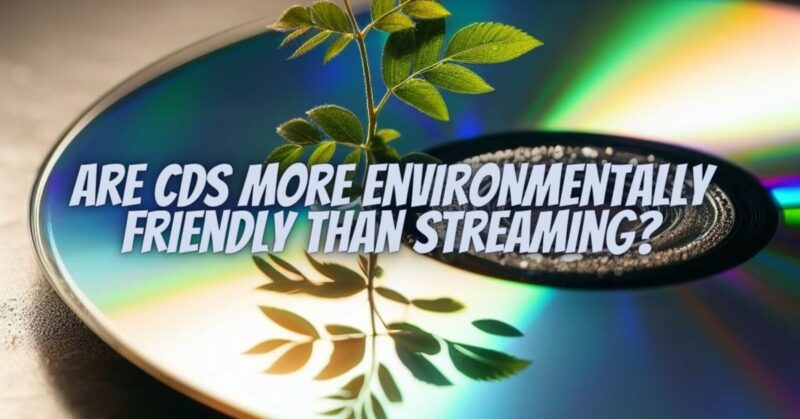The way we consume music has evolved significantly over the years, transitioning from physical formats like CDs to digital streaming services. With growing concerns about environmental sustainability, many music enthusiasts wonder whether CDs or streaming is the more eco-friendly option. In this comprehensive article, we will examine the environmental impact of both CDs and streaming, considering factors such as manufacturing, distribution, energy consumption, and waste generation.
CDs: The Physical Format
Compact Discs (CDs) were a groundbreaking innovation in music distribution, providing a durable and high-quality medium for storing and playing music. However, the environmental impact of CDs is a complex issue that involves various stages of production and disposal:
- Manufacturing: CD production involves the extraction of raw materials, such as polycarbonate plastic and aluminum for the disc, as well as the creation of the printed label and packaging materials. The manufacturing process consumes energy and generates greenhouse gas emissions.
- Distribution: CDs must be transported to retailers, which involves fuel consumption and carbon emissions. Moreover, the packaging and shipping materials contribute to waste.
- Playback: Playing CDs requires CD players, which consume electricity. However, CD players typically consume less energy compared to streaming devices.
- Disposal: When CDs reach the end of their lifespan, they can become electronic waste (e-waste) if not properly recycled. E-waste contains hazardous materials that can harm the environment if not managed correctly.
Streaming: The Digital Alternative
Streaming music has gained immense popularity due to its convenience and accessibility. While it eliminates many of the physical aspects associated with CDs, it has its own set of environmental considerations:
- Data Centers: Streaming services rely on massive data centers to store and deliver music content to users. These data centers consume significant amounts of electricity, which can be sourced from non-renewable energy.
- Device Energy Consumption: Streaming music requires electronic devices such as smartphones, computers, and smart speakers. The energy consumption of these devices varies but can be substantial, especially if users stream music continuously.
- Internet Infrastructure: The global internet infrastructure, including servers and data transmission, consumes energy and contributes to carbon emissions.
- E-Waste: While streaming eliminates the physical media aspect, electronic devices used for streaming have a limited lifespan and eventually become e-waste.
Comparing Environmental Impact
To determine whether CDs or streaming is more environmentally friendly, we must consider the entire lifecycle of each format:
- Resource Extraction: CDs require the extraction of raw materials, which can have negative environmental impacts. In contrast, streaming relies on existing infrastructure, avoiding this initial resource extraction.
- Energy Consumption: Streaming music consumes energy in data centers, device usage, and internet infrastructure. However, playing CDs also consumes energy, primarily in the form of electricity for CD players.
- Transportation: CDs involve transportation for manufacturing, distribution, and retail. Streaming eliminates the need for physical distribution but relies on internet infrastructure, which has its energy footprint.
- Waste Generation: CDs can contribute to e-waste when discarded. Streaming, on the other hand, reduces physical waste but contributes to electronic waste through devices.
- Renewable Energy: Both CD manufacturing and streaming data centers have the potential to use renewable energy sources, which can significantly reduce their carbon footprint.
The environmental impact of CDs and streaming is not straightforward and depends on various factors, including individual behavior and industry practices. Streaming music reduces physical waste but consumes significant energy, while CDs involve resource extraction and transportation but have a smaller ongoing energy footprint.
Ultimately, the environmental impact of your music consumption may vary depending on your choices and habits. To reduce your environmental footprint, consider options such as purchasing used CDs, using energy-efficient devices, and supporting streaming services that prioritize renewable energy sources. In the quest for more environmentally friendly music consumption, both formats have their merits and challenges, highlighting the importance of mindful choices and sustainable practices in the digital age.


